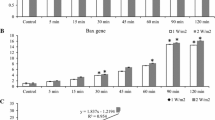Abstract
Experimental studies in mice and rats have shown that UV (B) irradiation leads to specific lens changes, viz. yellowing of the nucleus and a multilayered epithelium in the anterior pole with disrupted cortical fibres underneath. Biomicroscopic and ultrastructural studies on ageing human lenses revealed yellowing of the lens nucleus and locally ruptured membranes and small opcities in the equatorial cortex. No changes in the anterior pole were ever observed. This discrepancy between the human and animal lens, contraindicating UV as an important risk factor for human cataract, is discussed and may be due to several factors: (1) a difference between the high level acute and low level chronic irradiation; (2) species differences: nocturnal animals may be unable to cope with bright light exposure; (3) differences in scavenger and other defense mechanisms between humans and animals.
Similar content being viewed by others
References
Borkman RF. Cataracts and photochemical damage in the lens. In: Nugent J, Whelan J, eds. Human cataract formation. Ciba Foundn Symp 1984; 106: 88–109.
Harding J. Cataract: biochemistry, epidemiology and pharmacology. London: Chapman and Hall, 1991.
Jose JG, Pitts DG. Wavelength dependency of cataracts in albino mice following chronic exposure. Exp Eye Res 1985; 41: 545–63.
Jose JG, Rice RW. Histologic observations of lenses of albino mice with UV-B induced cataracts. Lens Res 1986; 3: 169–88.
Jose JG. Posterior cataract induction by UVB radiation in albino mice. Exp Eye Res 1986; 42: 11–20.
Schmidt J, Schmitt C, Wegener A, Hockwin O. Histological changes of rat lenses after UV-irradiation and D-penicillamine treatment. Ophthalmic Res 1993; 25: 69–76.
Wegener AR. In vivo studies on the effect of UV-radiation on the eye lens in animals. Doc Ophthalmol 1995; 88: 221–232.
Li L-K, So L, Spector A. Membrane cholesterol and phospholipid in consecutive concentric sections of human lens. J Lipid Res 1985; 26: 600–609.
Vrensen G, van Marle J, van Veen H, Willekens B. Membrane architecture as a function of lens fibre maturation: a freeze fracture and scanning electron microscopy study in the human lens. Exp Eye Res 1992; 54: 433–46.
van Marle J, Vrensen G, van Veen H. Maturing human eye lens fibre membranes and filipin cytochemistry. In: Vrensen GFJM, Clauwaert J, eds. Eye lens membranes and aging. Topics Ageing Res Europe 1991; 15: 123–34.
IJspeert JK. Light scattering in the human eye. Thesis, University of Amsterdam, 1993.
Horwitz J.α-Crystallin can function as a molecular chaperone. Proc Natl Acad Sci USA 1992; 89: 10449–53.
Obazawa H, Fujiwara T, Kawara T. The maturing process of the senile cataractous lens opacities. In: Henkind P, ed. Acta XXIV International Congress of Ophthalmology, 1993.
Vrensen GFJM, Willekens B. Biomicroscopy and scanning electron microscopy of early opacities in the aging human lens. Invest Ophthalmol Vis Sci 1990; 31: 1582–91.
Spector A. The search for a solution to senile cataracts. Invest Ophthalmol Vis Sci 1984; 25: 130–36.
Vrensen G, Kappelhof J, Willekens B. Morphology of the aging human lens. II. Ultrastructure of clear lenses. Lens Eye Tox Res 1990; 7: 1–30.
Gorthy WC, Steward DE, McDonald JK. Localization of the lysosomal protease dipeptidyl peptidase II in the young normal rat lens: a correlative light and electron microscopic analysis. Current Eye Res 1992; 11: 531–42.
Vrensen G, van Marle J, Willekens B, van Veen H. Square arrays in early cortical lens opacities. Invest Ophthalmol Vis Sci 1990; 31: 2476–81.
Brown NAP, Vrensen G, Shun-Shin GA, Willekens B. Lamellar separation in the lens: the case for fibre folds. Eye 1989; 3: 597–605.
Vrensen G. Discrepancy between onset of early lens changes and onset of senile cataract: The case for cellular defense systems in the human eye lens. Dev Ophthalmol 1991; 21: 129–33.
Zigler JS, Lucas VA, Du X-Y. Rhesus monkey lens as anin vitro model for studying oxidative stress. Invest Ophthalmol Vis Sci 1989; 30: 2195–99.
Brown NP, Harris ML, Shun-Shin GA, Vrensen GFJM, Willekens B, Bron AJ. Is cortical spoke cataract due to lens fibre breaks? The relationship between fibre folds, fibre breaks, waterclefts and spoke cataract. Eye 1993; 7: 672–79.
Taylor HR, West SK, Rosenthal FS, Muñoz B, Newland HS, Abbey H, Emmett EA. Effect of ultraviolet radiation on cataract formation. New Engl J Med. 1988; 319: 1430–33.
Sliney DH. UV radiation ocular exposure dosimetry. Doc Ophthalmol 1995; 88: 243–254.
Coroneo MT. Albedo concentration in the anterior eye: a phenomenon that locates some solar diseases. Ophthalmic Surg 1990; 21: 60–66.
Sasaki K, Karino K, Kojima M, Sakamoto Y, Takizawa A, Zeinuddin D, Katou N. Cataract survey in the local are a using photographic documentation. Dev Ophthalmol 1987; 15: 28–36.
Sasaki K, Kojima M. Population based cataract epidemiological surveys utilizing a photodocumentation system. Doc Ophthalmol 1995; 88: 277–283.
Author information
Authors and Affiliations
Rights and permissions
About this article
Cite this article
Vrensen, G.F.J.M. UV-B and early cortical and nuclear changes in the human lens. Doc Ophthalmol 88, 255–261 (1995). https://doi.org/10.1007/BF01203679
Issue Date:
DOI: https://doi.org/10.1007/BF01203679




